STS-123
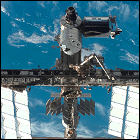 Space Shuttle Endeavour lifts off on the 122nd shuttle flight, a 16 day mission to deliver two new key components of the International Space Station. The unpressurized portion of the Japanese Aerospace Exploration Agency’s Kibo laboratory is delivered and attached, while the two-armed Dextre robotic arm system built in Canada is also installed. Aboard Endeavour for her 21st flight are Commander Dominic Gorie, Pilot Greg Johnson, and mission specialists Garrett Reisman, Robert Behnken, Mike Foreman, Takao Doi and Rick Linnehan. Reisman remains on the ISS, while station astronaut Leopold Eyharts hitches a ride back to Earth aboard the shuttle.
Space Shuttle Endeavour lifts off on the 122nd shuttle flight, a 16 day mission to deliver two new key components of the International Space Station. The unpressurized portion of the Japanese Aerospace Exploration Agency’s Kibo laboratory is delivered and attached, while the two-armed Dextre robotic arm system built in Canada is also installed. Aboard Endeavour for her 21st flight are Commander Dominic Gorie, Pilot Greg Johnson, and mission specialists Garrett Reisman, Robert Behnken, Mike Foreman, Takao Doi and Rick Linnehan. Reisman remains on the ISS, while station astronaut Leopold Eyharts hitches a ride back to Earth aboard the shuttle.
STS-122
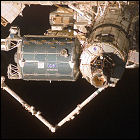 Space Shuttle Atlantis lifts off on the 121st shuttle flight, a 13-day mission to deliver another laboratory module to the International Space Station. The European Space Agency’s Columbus lab module is ESA’s contribution to the station, and is attached to the recently-installed Harmony node over the course of three spacewalks. Aboard Atlantis for her 29th flight are Commander Steve Frick, Pilot Alan Poindexter, and mission specialists Stanley Love, Leland Melvin, Rex Walheim and Hans Schlegel. ISS Expedition 17 crewmember Leopold Eyharts travels to the station aboard Atlantis, while ISS Expedition 16 crewmember Daniel Tani returns to Earth on the shuttle in his place.
Space Shuttle Atlantis lifts off on the 121st shuttle flight, a 13-day mission to deliver another laboratory module to the International Space Station. The European Space Agency’s Columbus lab module is ESA’s contribution to the station, and is attached to the recently-installed Harmony node over the course of three spacewalks. Aboard Atlantis for her 29th flight are Commander Steve Frick, Pilot Alan Poindexter, and mission specialists Stanley Love, Leland Melvin, Rex Walheim and Hans Schlegel. ISS Expedition 17 crewmember Leopold Eyharts travels to the station aboard Atlantis, while ISS Expedition 16 crewmember Daniel Tani returns to Earth on the shuttle in his place.
STS-120
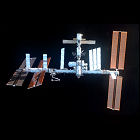 Space Shuttle Discovery lifts off on the 120th shuttle flight, a 15-day mission to deliver a new module to the International Space Station. The module in question is the Harmony node, which adds space for further modules to be added by future shuttle missions. Aboard Discovery for her 34th mission are Commander Pamela Melroy, Pilot George Zamka, mission specialists Douglas Wheelock, Scott Parazynski, Stephanie Wilson and Paolo Nespoli, and ISS Expedition 16 crewmember Daniel Tani, who remains on the station. Among the items stowed away aboard the shuttle are the screen-used lightsaber prop wielded by Luke Skywalker in Return Of The Jedi.
Space Shuttle Discovery lifts off on the 120th shuttle flight, a 15-day mission to deliver a new module to the International Space Station. The module in question is the Harmony node, which adds space for further modules to be added by future shuttle missions. Aboard Discovery for her 34th mission are Commander Pamela Melroy, Pilot George Zamka, mission specialists Douglas Wheelock, Scott Parazynski, Stephanie Wilson and Paolo Nespoli, and ISS Expedition 16 crewmember Daniel Tani, who remains on the station. Among the items stowed away aboard the shuttle are the screen-used lightsaber prop wielded by Luke Skywalker in Return Of The Jedi.
Soyuz TMA-11 / ISS Expedition 16
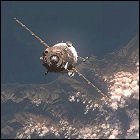 The sixteenth full-time crew of the International Space Station lifts off from Russia’s Baikonur Cosmodrome aboard Soyuz TMA-11. Yuri Malenchenko and Peggy Whitson take up residence on the ISS for 196 days. Arriving with them on the ISS for a ten-day stay is Malaysian space tourist Sheikh Muszaphar Shukor, who returns to Earth aboard Soyuz TMA-10 with the Expedition 15 crew. Like other “space tourists” before him, he has paid for his own Soyuz seat and mission training. When Malenchenko and Whitson return in April 2008 with South Korean astronaut Yi So-Yeon, the Soyuz suffers a dangerous malfunction, failing to jettison its service module; the result is an off-balance spacecraft that re-enters the atmosphere nose-first, exposing under-insulated portions of the vehicle to the heat of re-entry and forcing the crew to endure 10 Gs. The vehicle lands nearly 300 miles off-course and Yi So-Yeon suffers neck and spinal injuries in the landing; the head of the Russian space program doesn’t improve matters by blaming these events on an “old Russian superstition” that having more women than men in a vehicle is bad luck. NASA and Russian space engineers begin investigating the mishap, finally arriving at the more plausible explanation of a malfunctioning spacecraft.
The sixteenth full-time crew of the International Space Station lifts off from Russia’s Baikonur Cosmodrome aboard Soyuz TMA-11. Yuri Malenchenko and Peggy Whitson take up residence on the ISS for 196 days. Arriving with them on the ISS for a ten-day stay is Malaysian space tourist Sheikh Muszaphar Shukor, who returns to Earth aboard Soyuz TMA-10 with the Expedition 15 crew. Like other “space tourists” before him, he has paid for his own Soyuz seat and mission training. When Malenchenko and Whitson return in April 2008 with South Korean astronaut Yi So-Yeon, the Soyuz suffers a dangerous malfunction, failing to jettison its service module; the result is an off-balance spacecraft that re-enters the atmosphere nose-first, exposing under-insulated portions of the vehicle to the heat of re-entry and forcing the crew to endure 10 Gs. The vehicle lands nearly 300 miles off-course and Yi So-Yeon suffers neck and spinal injuries in the landing; the head of the Russian space program doesn’t improve matters by blaming these events on an “old Russian superstition” that having more women than men in a vehicle is bad luck. NASA and Russian space engineers begin investigating the mishap, finally arriving at the more plausible explanation of a malfunctioning spacecraft.
STS-118 puts a teacher in space
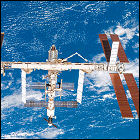 Space Shuttle Endeavour lifts off on the 119th shuttle flight, a 12-day mission to the International Space Station. Additional truss sections are delivered and installed at the station to support solar power arrays, along with the delivery of 5,000 pounds of supplies, consumables and experiments. Aboard Endeavour for her 20th flight are Commander Scott Kelly, Pilot Charles Hobaugh, and mission specialists Richard Mastracchio, Dr. Dafydd Williams, Barbara Morgan, Dr. Tracy Caldwell and Benjamin Drew. Morgan is the first Teacher In Space, having been Christa McAuliffe’s backup in the 1980s, finally fulfilling the Teacher In Space program after 21 years.
Space Shuttle Endeavour lifts off on the 119th shuttle flight, a 12-day mission to the International Space Station. Additional truss sections are delivered and installed at the station to support solar power arrays, along with the delivery of 5,000 pounds of supplies, consumables and experiments. Aboard Endeavour for her 20th flight are Commander Scott Kelly, Pilot Charles Hobaugh, and mission specialists Richard Mastracchio, Dr. Dafydd Williams, Barbara Morgan, Dr. Tracy Caldwell and Benjamin Drew. Morgan is the first Teacher In Space, having been Christa McAuliffe’s backup in the 1980s, finally fulfilling the Teacher In Space program after 21 years.
STS-117
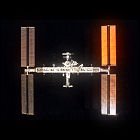 Space Shuttle Atlantis lifts off the 118th shuttle flight, on a two-week mission to resupply and continue assembly of the International Space Station. Two major structural trusses and two large solar power arrays are delivered and installed, and a damaged array is removed. Aboard Atlantis for her 28th flight are Commander Rick Sturckow, Pilot Lee Archambault, and mission specialists Patrick Forrester, Danny Olivas, Clayton Anderson, Jim Reilly and Steven Swanson. Anderson remains on the station, joining the crew of ISS Expedition 15.
Space Shuttle Atlantis lifts off the 118th shuttle flight, on a two-week mission to resupply and continue assembly of the International Space Station. Two major structural trusses and two large solar power arrays are delivered and installed, and a damaged array is removed. Aboard Atlantis for her 28th flight are Commander Rick Sturckow, Pilot Lee Archambault, and mission specialists Patrick Forrester, Danny Olivas, Clayton Anderson, Jim Reilly and Steven Swanson. Anderson remains on the station, joining the crew of ISS Expedition 15.
Soyuz TMA-10 / ISS Expedition 15
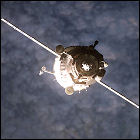 The fifteenth full-time crew of the International Space Station lifts off from Russia’s Baikonur Cosmodrome aboard Soyuz TMA-10. Oleg Kotov and Fyodor Yurchikhin take up residence on the ISS for 196 days. Arriving with them on the ISS for an 11-day stay is space tourist Charles Simonyi, a Microsoft software engineer (whose successes included such widely-used software as Microsoft Word and Excel), who returns to Earth aboard Soyuz TMA-9 with the Expedition 14 crew. Like other “space tourists” before him, he has paid for his own Soyuz seat and mission training. When Kotov and Yurchikhin return in October 2007, the Soyuz suffers a dangerous malfunction, failing to jettison its service module; the result is an off-balance spacecraft that re-enters the atmosphere nose-first, exposing under-insulated portions of the vehicle to the heat of re-entry. The crew manages a survivable landing, but news of the incident is kept quiet by the Russian space program until a similar mishap occurs aboard the next Soyuz flight.
The fifteenth full-time crew of the International Space Station lifts off from Russia’s Baikonur Cosmodrome aboard Soyuz TMA-10. Oleg Kotov and Fyodor Yurchikhin take up residence on the ISS for 196 days. Arriving with them on the ISS for an 11-day stay is space tourist Charles Simonyi, a Microsoft software engineer (whose successes included such widely-used software as Microsoft Word and Excel), who returns to Earth aboard Soyuz TMA-9 with the Expedition 14 crew. Like other “space tourists” before him, he has paid for his own Soyuz seat and mission training. When Kotov and Yurchikhin return in October 2007, the Soyuz suffers a dangerous malfunction, failing to jettison its service module; the result is an off-balance spacecraft that re-enters the atmosphere nose-first, exposing under-insulated portions of the vehicle to the heat of re-entry. The crew manages a survivable landing, but news of the incident is kept quiet by the Russian space program until a similar mishap occurs aboard the next Soyuz flight.
Soyuz TMA-9 / Expedition 14
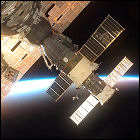 The fourteenth full-time crew of the International Space Station lifts off from Russia’s Baikonur Cosmodrome aboard Soyuz TMA-9. Mikhail Tyurin and Michael López-Alegría take up residence on the ISS for 215 days; with the American space shuttle fleet back in action, longer ISS stays with larger crews are once again possible.. Arriving with them on the ISS for a nine-day stay is Iranian-born telecommunications entrepreneur (and Ansari X-Prize founder) Anousheh Ansari, who returns to Earth aboard Soyuz TMA-8 with the Expedition 13 crew. Like other “space tourists” before her, she has paid for her own Soyuz seat and mission training.
The fourteenth full-time crew of the International Space Station lifts off from Russia’s Baikonur Cosmodrome aboard Soyuz TMA-9. Mikhail Tyurin and Michael López-Alegría take up residence on the ISS for 215 days; with the American space shuttle fleet back in action, longer ISS stays with larger crews are once again possible.. Arriving with them on the ISS for a nine-day stay is Iranian-born telecommunications entrepreneur (and Ansari X-Prize founder) Anousheh Ansari, who returns to Earth aboard Soyuz TMA-8 with the Expedition 13 crew. Like other “space tourists” before her, she has paid for her own Soyuz seat and mission training.
NASA, SpaceX sign cargo launch agreement
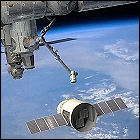 Impressed with the progress shown by the commercial spaceflight industry, NASA signs agreements with SpaceX, a venture started by PayPal founder Elon Musk, and Oklahoma-based Rocketplane Kistler (RPK) to begin developing spacecraft that can deliver cargo and, later, astronauts to the International Space Station. RPK’s bid eventually collapses in financial scandal, though SpaceX goes on to create Dragon, the first privately-funded vehicle to visit the ISS in 2012.
Impressed with the progress shown by the commercial spaceflight industry, NASA signs agreements with SpaceX, a venture started by PayPal founder Elon Musk, and Oklahoma-based Rocketplane Kistler (RPK) to begin developing spacecraft that can deliver cargo and, later, astronauts to the International Space Station. RPK’s bid eventually collapses in financial scandal, though SpaceX goes on to create Dragon, the first privately-funded vehicle to visit the ISS in 2012.
Soyuz TMA-8 / ISS Expedition 13
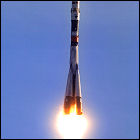 The thirteenth full-time crew of the International Space Station lifts off from Russia’s Baikonur Cosmodrome aboard Soyuz TMA-8. Pavel Vinogradov and Jeffrey Williams take up residence on the ISS for 182 days; during their stay, the ISS crew expands to three with the arrival of Thomas Reiter aboard space shuttle Discovery, marking the remaining shuttle fleet’s temporary return to service. Arriving with them on the ISS for a nine-day stay is Brazilian astronaut Marcos Pontes, who returns to Earth aboard Soyuz TMA-7 with the Expedition 12 crew.
The thirteenth full-time crew of the International Space Station lifts off from Russia’s Baikonur Cosmodrome aboard Soyuz TMA-8. Pavel Vinogradov and Jeffrey Williams take up residence on the ISS for 182 days; during their stay, the ISS crew expands to three with the arrival of Thomas Reiter aboard space shuttle Discovery, marking the remaining shuttle fleet’s temporary return to service. Arriving with them on the ISS for a nine-day stay is Brazilian astronaut Marcos Pontes, who returns to Earth aboard Soyuz TMA-7 with the Expedition 12 crew.
Soyuz TMA-7 / ISS Expedition 12
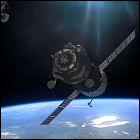 The twelfth full-time crew of the International Space Station lifts off from Russia’s Baikonur Cosmodrome aboard Soyuz TMA-7. Valery Tokarev and William McArthur take up residence on the ISS for 189 days. Arriving with them on the ISS for a nine-day stay is space tourist and entrepreneur Gregory Olsen, who personally funded his own trip aboard the Soyuz and returns to Earth aboard Soyuz TMA-6 with the Expedition 11 crew.
The twelfth full-time crew of the International Space Station lifts off from Russia’s Baikonur Cosmodrome aboard Soyuz TMA-7. Valery Tokarev and William McArthur take up residence on the ISS for 189 days. Arriving with them on the ISS for a nine-day stay is space tourist and entrepreneur Gregory Olsen, who personally funded his own trip aboard the Soyuz and returns to Earth aboard Soyuz TMA-6 with the Expedition 11 crew.
Soyuz TMA-6 / ISS Expedition 11
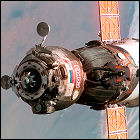 The eleventh full-time crew of the International Space Station lifts off from Russia’s Baikonur Cosmodrome aboard Soyuz TMA-6. Sergei Krikalev and John Phillips take up residence on the ISS for 179 days. Arriving with them on the ISS for a nine-day stay is astronaut Roberto Vittori, who returns to Earth aboard Soyuz TMA-5 with the Expedition 10 crew.
The eleventh full-time crew of the International Space Station lifts off from Russia’s Baikonur Cosmodrome aboard Soyuz TMA-6. Sergei Krikalev and John Phillips take up residence on the ISS for 179 days. Arriving with them on the ISS for a nine-day stay is astronaut Roberto Vittori, who returns to Earth aboard Soyuz TMA-5 with the Expedition 10 crew.
Expedition 10 makes a meal of the ISSues
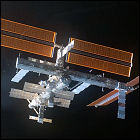 NASA orders the crew of the International Space Station to cut back on meals. Without the Space Shuttle delivering supplies to the station, resupply missions have been flown only by Russia’s much smaller unmanned Progress capsules, but the station was never designed to be restocked by Progress alone. Astronaut Leroy Chiao and cosmonaut Salizhan Sharipov are ordered to cut back on calories – with a reduction in workload to match – until more food arrives on a Progress capsule scheduled for liftoff on Christmas Eve. A failure of that flight could lead to an order to abandon the station.
NASA orders the crew of the International Space Station to cut back on meals. Without the Space Shuttle delivering supplies to the station, resupply missions have been flown only by Russia’s much smaller unmanned Progress capsules, but the station was never designed to be restocked by Progress alone. Astronaut Leroy Chiao and cosmonaut Salizhan Sharipov are ordered to cut back on calories – with a reduction in workload to match – until more food arrives on a Progress capsule scheduled for liftoff on Christmas Eve. A failure of that flight could lead to an order to abandon the station.
Soyuz TMA-5 / ISS Expedition 10
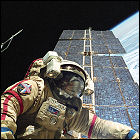 The tenth full-time crew of the International Space Station lifts off from Russia’s Baikonur Cosmodrome aboard Soyuz TMA-5. Salizhan Sharipov and Leroy Chiao take up residence on the ISS for 192 days. Arriving with them on the ISS for a nine-day stay is cosmonaut Yuri Shargin, who returns to Earth aboard Soyuz TMA-4 with the Expedition 9 crew.
The tenth full-time crew of the International Space Station lifts off from Russia’s Baikonur Cosmodrome aboard Soyuz TMA-5. Salizhan Sharipov and Leroy Chiao take up residence on the ISS for 192 days. Arriving with them on the ISS for a nine-day stay is cosmonaut Yuri Shargin, who returns to Earth aboard Soyuz TMA-4 with the Expedition 9 crew.
Risky spacewalk called off
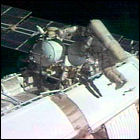 A risky spacewalk at the International Space Station is called off hurriedly, with astronaut Mike Fincke already through the open hatch. The oxygen container on Fincke’s spacesuit is the cause for concern, as mission controllers in Russia note that its pressure is rapidly dropping. Fincke and mission commander Gennady Padalka were en route to replace a circuit breaker, but due to a variety of other problems aboard the station they were exiting the station via the Russian-built airlock at the opposite end of the station from the breaker’s destination, requiring a 45-minute journey from one end of the station to the other. The spacewalk, rescheduled for a later date, will leave the station unoccupied with its entire crew outside for only the second time since the station became operational.
A risky spacewalk at the International Space Station is called off hurriedly, with astronaut Mike Fincke already through the open hatch. The oxygen container on Fincke’s spacesuit is the cause for concern, as mission controllers in Russia note that its pressure is rapidly dropping. Fincke and mission commander Gennady Padalka were en route to replace a circuit breaker, but due to a variety of other problems aboard the station they were exiting the station via the Russian-built airlock at the opposite end of the station from the breaker’s destination, requiring a 45-minute journey from one end of the station to the other. The spacewalk, rescheduled for a later date, will leave the station unoccupied with its entire crew outside for only the second time since the station became operational.
ISS Expedition 9 gets dizzying welcome
 The three members of the Expedition 9 crew arrive on the International Space Station, and the station promptly loses one of its three gyroscopes, which keep the station aligned in orbit. According to NASA, the station can remain stable with only two of the gyroscopes operating, and even if a second one should fail, the thrusters of the newly-arrived Soyuz capsule can keep it aligned. Departing in their Soyuz vehicle will be Expedition 8 crewmembers Michael Foale and Alexander Kaleri, along with ESA astronaut Andrè Kuipers, who arrived with the Expedition 9 crew to perform a week’s worth of experiments. Manning the station for the next six months will be Commander Gennady Padalka and Flight Engineer Mike Fincke.
The three members of the Expedition 9 crew arrive on the International Space Station, and the station promptly loses one of its three gyroscopes, which keep the station aligned in orbit. According to NASA, the station can remain stable with only two of the gyroscopes operating, and even if a second one should fail, the thrusters of the newly-arrived Soyuz capsule can keep it aligned. Departing in their Soyuz vehicle will be Expedition 8 crewmembers Michael Foale and Alexander Kaleri, along with ESA astronaut Andrè Kuipers, who arrived with the Expedition 9 crew to perform a week’s worth of experiments. Manning the station for the next six months will be Commander Gennady Padalka and Flight Engineer Mike Fincke.
Soyuz TMA-4 / ISS Expedition 9
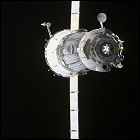 The ninth full-time crew of the International Space Station lifts off from Russia’s Baikonur Cosmodrome aboard Soyuz TMA-4. Gennady Padalka and Michael Fincke take up residence on the ISS for 187 days. Arriving with them on the ISS for a ten-day stay is Dutch astronaut Andre Kuipers, who returns to Earth aboard Soyuz TMA-3 with the Expedition 8 crew.
The ninth full-time crew of the International Space Station lifts off from Russia’s Baikonur Cosmodrome aboard Soyuz TMA-4. Gennady Padalka and Michael Fincke take up residence on the ISS for 187 days. Arriving with them on the ISS for a ten-day stay is Dutch astronaut Andre Kuipers, who returns to Earth aboard Soyuz TMA-3 with the Expedition 8 crew.
Soyuz TMA-3 / ISS Expedition 8
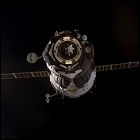 The eighth full-time crew of the International Space Station lifts off from Russia’s Baikonur Cosmodrome aboard Soyuz TMA-3. Alexander Kaleri and Michael Foale take up residence on the ISS for 194 days, both of them veterans of long-term stays aboard the Mir space station; arriving on the ISS with them for a ten-day stay is Spanish astronaut Pedro Duque, who returns to Earth aboard Soyuz TMA-2 with the Expedition 7 crew.
The eighth full-time crew of the International Space Station lifts off from Russia’s Baikonur Cosmodrome aboard Soyuz TMA-3. Alexander Kaleri and Michael Foale take up residence on the ISS for 194 days, both of them veterans of long-term stays aboard the Mir space station; arriving on the ISS with them for a ten-day stay is Spanish astronaut Pedro Duque, who returns to Earth aboard Soyuz TMA-2 with the Expedition 7 crew.
Apollo rides again?
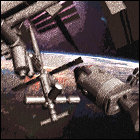 Last flown in the 1975 Apollo-Soyuz mission, the Apollo command/service module is – briefly – given strong consideration by NASA to serve as a “lifeboat” for the crew of the International Space Station, even to the point of conducting a study about un-mothballing the surviving unused Apollo hardware sitting in museums around the world. Part of the reason for this unusual study is that NASA’s budget has run out for finding a workable solution to keeping a “lifeboat” available to station astronauts in the anticipated long gap before the Space Shuttle’s return to service. Ultimately, even the seemingly unthinkable return of Apollo is nixed, since at least a Saturn IB booster would need to be similarly refitted – at huge expense – to lift a 30-year-old Apollo capsule into space.
Last flown in the 1975 Apollo-Soyuz mission, the Apollo command/service module is – briefly – given strong consideration by NASA to serve as a “lifeboat” for the crew of the International Space Station, even to the point of conducting a study about un-mothballing the surviving unused Apollo hardware sitting in museums around the world. Part of the reason for this unusual study is that NASA’s budget has run out for finding a workable solution to keeping a “lifeboat” available to station astronauts in the anticipated long gap before the Space Shuttle’s return to service. Ultimately, even the seemingly unthinkable return of Apollo is nixed, since at least a Saturn IB booster would need to be similarly refitted – at huge expense – to lift a 30-year-old Apollo capsule into space.
Soyuz TMA-2 / ISS Expedition 7
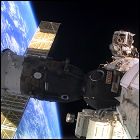 The seventh full-time crew of the International Space Station lifts off from Russia aboard Soyuz TMA-2, a drastic change from their original mission plan. Originally planned to be another short-term “ferry flight” to swap out the station’s Soyuz lifeboat vehicle, Soyuz became the only way to send full-time crews to the station during the post-Columbia-disaster grounding of the American shuttle fleet. Yuri Malenchenko and Ed Lu took up residence aboard the ISS for 184 days, returning in October 2003 with Spanish astronaut Pedro Duque. With the shuttle fleet landlocked, two-man ISS crews became the norm, as three-man crews relied on the greater resupply capacity of the shuttles.
The seventh full-time crew of the International Space Station lifts off from Russia aboard Soyuz TMA-2, a drastic change from their original mission plan. Originally planned to be another short-term “ferry flight” to swap out the station’s Soyuz lifeboat vehicle, Soyuz became the only way to send full-time crews to the station during the post-Columbia-disaster grounding of the American shuttle fleet. Yuri Malenchenko and Ed Lu took up residence aboard the ISS for 184 days, returning in October 2003 with Spanish astronaut Pedro Duque. With the shuttle fleet landlocked, two-man ISS crews became the norm, as three-man crews relied on the greater resupply capacity of the shuttles.
STS-113 / ISS Expedition 6
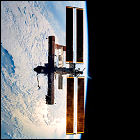 Space Shuttle Endeavour lifts off on the 112th shuttle flight, a two-week mission to resupply and exchange crews at the International Space Station. Another structural tress to dissipate excess heat into space is assembled and attached. Aboard Endeavour for her 19th flight are Commander James Wetherbee, Pilot Paul Lockhart, mission specialists Michael Lopez-Alegria and John Herrington, and ISS Expedition 6 crewmembers Kenneth Bowersox, Nikolai Budarin and Don Pettit. Returning to Earth aboard the shuttle are Expedition 5 crewmembers Valeri Korzun, Peggy Whitson and Sergei Treschev.
Space Shuttle Endeavour lifts off on the 112th shuttle flight, a two-week mission to resupply and exchange crews at the International Space Station. Another structural tress to dissipate excess heat into space is assembled and attached. Aboard Endeavour for her 19th flight are Commander James Wetherbee, Pilot Paul Lockhart, mission specialists Michael Lopez-Alegria and John Herrington, and ISS Expedition 6 crewmembers Kenneth Bowersox, Nikolai Budarin and Don Pettit. Returning to Earth aboard the shuttle are Expedition 5 crewmembers Valeri Korzun, Peggy Whitson and Sergei Treschev.
This is the last successful shuttle mission for over two years.
Soyuz TMA-1: the only ride in town
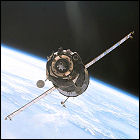 Russia launches a new variant of the venerable Soyuz spacecraft, Soyuz TMA-1, on a mission to the International Space Station. Cosmonauts Sergei Zalyotin and Yury Lonchakov and Belgian astronaut
Russia launches a new variant of the venerable Soyuz spacecraft, Soyuz TMA-1, on a mission to the International Space Station. Cosmonauts Sergei Zalyotin and Yury Lonchakov and Belgian astronaut
Frank De Winne visit the ISS for 11 days, conducting experiments and bringing supplies to the station. This crew returns to Earth aboard Soyuz TM-34, leaving Soyuz TMA-1 at the ISS. When the space shuttle fleet is grounded early in 2003 after the Columbia disaster, Soyuz TMA-1, still berthed at the ISS, becomes the only ride home for the station’s sixth full-time crew.
STS-112
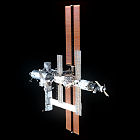 Space Shuttle Atlantis lifts off on the 111th shuttle flight, an 11-day construction mission to the International Space Station. Another major structural truss is assembled and attached, serving the primary function of radiating built-up waste heat away from the station and into space. Aboard Atlantis for her 26th flight are Commander Jeff Ashby, Pilot Pamela Melroy, and mission specialists David Wolf, Piers Sellers, Sandra Magnus and Fyodor Yurchikhin.
Space Shuttle Atlantis lifts off on the 111th shuttle flight, an 11-day construction mission to the International Space Station. Another major structural truss is assembled and attached, serving the primary function of radiating built-up waste heat away from the station and into space. Aboard Atlantis for her 26th flight are Commander Jeff Ashby, Pilot Pamela Melroy, and mission specialists David Wolf, Piers Sellers, Sandra Magnus and Fyodor Yurchikhin.
STS-111 / ISS Expedition 5
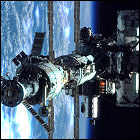 Space Shuttle Endeavour lifts off on the 110th shuttle flight, a mission to exchange the crew of the International Space Station. Scheduled supplies and other equipment are also transported to the station. Aboard Endeavour for her 18th flight are Commander Kenneth Cockrell, Pilot Paul Lockhart, mission specialists Franklin Chang-Diaz and Philippe Perrin, and ISS Expedition 5 crewmembers Valeri Korzun, Peggy Whitson and Sergei Treschev. Returning to Earth aboard the shuttle are ISS Expedition 4 crewmembers Yuri Onufriyenko, Carl Walz and Daniel Bursch.
Space Shuttle Endeavour lifts off on the 110th shuttle flight, a mission to exchange the crew of the International Space Station. Scheduled supplies and other equipment are also transported to the station. Aboard Endeavour for her 18th flight are Commander Kenneth Cockrell, Pilot Paul Lockhart, mission specialists Franklin Chang-Diaz and Philippe Perrin, and ISS Expedition 5 crewmembers Valeri Korzun, Peggy Whitson and Sergei Treschev. Returning to Earth aboard the shuttle are ISS Expedition 4 crewmembers Yuri Onufriyenko, Carl Walz and Daniel Bursch.
Soyuz TM-34
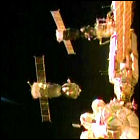 Russia launches a short-term visiting crew to the International Space Station aboard Soyuz TM-34. This is the last Soyuz TM class vehicle to fly, with a newer version of the capsule, Soyuz TMA, scheduled to launch later in 2002. Russian cosmonaut Yuri Gidzenko, Italian astronaut Roberto Vittori, and South African space tourist Mark Shuttleworth comprise Soyuz TM-34’s crew, staying at the ISS for eight days. Like Dennis Tito before him, multi-millionaire and Linux developer Shuttleworth has paid for his own ride into space. This crew leaves the Soyuz TM-34 vehicle at the ISS, returning home aboard Soyuz TM-33.
Russia launches a short-term visiting crew to the International Space Station aboard Soyuz TM-34. This is the last Soyuz TM class vehicle to fly, with a newer version of the capsule, Soyuz TMA, scheduled to launch later in 2002. Russian cosmonaut Yuri Gidzenko, Italian astronaut Roberto Vittori, and South African space tourist Mark Shuttleworth comprise Soyuz TM-34’s crew, staying at the ISS for eight days. Like Dennis Tito before him, multi-millionaire and Linux developer Shuttleworth has paid for his own ride into space. This crew leaves the Soyuz TM-34 vehicle at the ISS, returning home aboard Soyuz TM-33.
STS-110: giving ISS its backbone
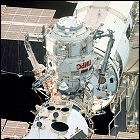 Space Shuttle Atlantis lifts off on the 109th shuttle flight, an 11-day mission to add the integrated truss “backbone” to the International Space Station. In addition to assembling and attaching this major part of the station, a mobile transport is added for the station’s remote manipulator arm, allowing the arm to roll from one end of the station to the other for whatever functions may be required. Aboard Atlantis for her 25th flight are Commander Michael Bloomfield, Pilot Stephen Frick, and mission specialists Jerry Ross, Steven Smith, Ellen Ochoa, Lee Morin and Rex Walheim.
Space Shuttle Atlantis lifts off on the 109th shuttle flight, an 11-day mission to add the integrated truss “backbone” to the International Space Station. In addition to assembling and attaching this major part of the station, a mobile transport is added for the station’s remote manipulator arm, allowing the arm to roll from one end of the station to the other for whatever functions may be required. Aboard Atlantis for her 25th flight are Commander Michael Bloomfield, Pilot Stephen Frick, and mission specialists Jerry Ross, Steven Smith, Ellen Ochoa, Lee Morin and Rex Walheim.
STS-108 / ISS Expedition 4
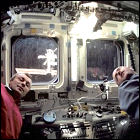 Space Shuttle Endeavour lifts off on the 107th shuttle flight, a resupply and crew rotation mission to the International Space Station. Aboard Endeavour for her 17th flight are Commander Dominic Gorie, Pilot Mark Kelly, mission specialists Linda Godwin and Daniel Tani, and ISS Expedition 4 crewmembers Yuri Onufrienko, Carl Walz and Daniel Bursch. Returning to Earth via Endeavour are ISS Expedition 3 crewmembers Frank Culbertson, Mikhail Turin and Vladimir Dezhurov.
Space Shuttle Endeavour lifts off on the 107th shuttle flight, a resupply and crew rotation mission to the International Space Station. Aboard Endeavour for her 17th flight are Commander Dominic Gorie, Pilot Mark Kelly, mission specialists Linda Godwin and Daniel Tani, and ISS Expedition 4 crewmembers Yuri Onufrienko, Carl Walz and Daniel Bursch. Returning to Earth via Endeavour are ISS Expedition 3 crewmembers Frank Culbertson, Mikhail Turin and Vladimir Dezhurov.
Soyuz TM-33
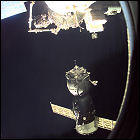 Russia launches Soyuz TM-33 on a mission to the International Space Station. Aboard the Soyuz are cosmonauts Viktor Afanasyev and Konstantin Kozeyev, and French spationaut Claudie Haigneré, making her second visit to a space station (she has previously visited Russia’s Mir space station). This is a short-term visiting crew, spending only eight days aboard Mir and then returning aboard the older Soyuz TM-32 spacecraft, leaving TM-33 as the return vehicle for the next visiting crew.
Russia launches Soyuz TM-33 on a mission to the International Space Station. Aboard the Soyuz are cosmonauts Viktor Afanasyev and Konstantin Kozeyev, and French spationaut Claudie Haigneré, making her second visit to a space station (she has previously visited Russia’s Mir space station). This is a short-term visiting crew, spending only eight days aboard Mir and then returning aboard the older Soyuz TM-32 spacecraft, leaving TM-33 as the return vehicle for the next visiting crew.
ISS: Pirs module launched
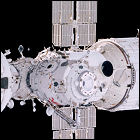 Russia launches the Pirs docking module into orbit, where automatic systems allow it to rendezvous with the International Space Station for docking to the existing Zvezda module. The Pirs module adds a docking port for Soyuz capsules, as well as an airlock for future spacewalks.
Russia launches the Pirs docking module into orbit, where automatic systems allow it to rendezvous with the International Space Station for docking to the existing Zvezda module. The Pirs module adds a docking port for Soyuz capsules, as well as an airlock for future spacewalks.
STS-105 / ISS Expedition 3
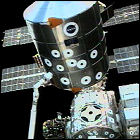 Space Shuttle Discovery lifts off on the 106th shuttle flight, a mission to exchange crews aboard the International Space Station. The shuttle’s cargo bay carries a logistics module containing more equipment for the ISS laboratory module, as well as storage racks to be installed elsewhere in the station. Aboard Discovery for her 30th flight are Commander Scott Horowitz, Pilot Frederick Sturckow, missions specialists Daniel Barry and Patrick Forrester, and ISS Expedition 3 crewmembers Frank Culbertson, Mikhail Turin and Vladimir Dezhurov, who remain aboard the station. Returning to Earth via Discovery are ISS Expedition 2 crewmembers Yury Usachev, James Voss and Susan Helms.
Space Shuttle Discovery lifts off on the 106th shuttle flight, a mission to exchange crews aboard the International Space Station. The shuttle’s cargo bay carries a logistics module containing more equipment for the ISS laboratory module, as well as storage racks to be installed elsewhere in the station. Aboard Discovery for her 30th flight are Commander Scott Horowitz, Pilot Frederick Sturckow, missions specialists Daniel Barry and Patrick Forrester, and ISS Expedition 3 crewmembers Frank Culbertson, Mikhail Turin and Vladimir Dezhurov, who remain aboard the station. Returning to Earth via Discovery are ISS Expedition 2 crewmembers Yury Usachev, James Voss and Susan Helms.